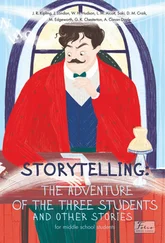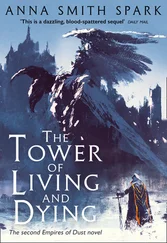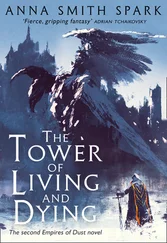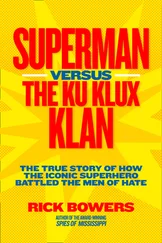Only his contract trainer, Whitey, was unfazed by his jockey’s behavior. This needled Woolf. To raise Whitey’s blood pressure a bit, Woolf started delaying his horses’ rallies until the last possible second. He would send a friend to sit nearby and watch the color drain from Whitey’s face as Woolf waited, and waited, and waited before driving for the lead just when it seemed too late. Whitey surely whitened a little more with every closing kick, but the Iceman knew what he was doing. Incredibly, Woolf’s timing was so good that he rode for more than a decade before he was beaten in a photo finishof a stakes race.
Woolf was fanatical about clean riding. He never initiated any rough riding tactics, and took justice into his own hands when anyone fouled him. He was known to haul off and crack offending riders right in the mouth with his whip, then frankly tell the stewards exactly what he’d done when a lie could have gotten him out of trouble. He rode claiming races with as much zeal as he rode the Santa Anita Handicap. He was also not above a little playful heckling; a few choice words from the Iceman could spook his rivals into blowing their game plans.
George Woolf, from the very beginning, stood a rung above Red Pollard. While Pollard bedded down in a horse stall at night and grazed out of the track kitchen, Woolf lived in the comfort of Whitey’s house, eating home-cooked meals. Pollard would never escape Woolf’s shadow, but he was not a jealous man. “I know George,” he would laugh. “ Big head, little ass, and roars like a lion.” Pollard, famously, tried to take credit for giving Woolf the nickname Iceman, explaining it thus: “In all the smoking-car stories I have ever heard, icemen and traveling salesmenwere very immoral characters. George does not have a pleasing enough personality to be a traveling salesman.”
Woolf replied in the same vein. “You don’t have to be an athlete to be a jockey,” he told a reporter. “Why, Red Pollard is one of the smartest jockeys in the country today, and he doesn’t have the strength to blow out a candle.”
In those early days, Pollard and Woolf found common ground in their quick minds, cerebral riding styles, and keen senses of humor. On the backstretch of Vancouver Race Course in the summer of 1927, a friendship was forged in the crucible of the racetrack and adolescence. It would endure long into manhood and bind them together in history.
1 In 1991, George Pratt, Ph.D., of the Massachusetts Institute of Technology used high speed cameras, race films, and computer analysis to gauge the speed of high-class quarter horses at Los Alamitos Racecourse, recording a top speed of 52 1/2 miles per hour for one horse. According to Pratt’s analysis, quarter mile world record setter Truckle Feature had a peak speed of just under 80 feet per second, or 54 mph. Note that this reflects top speed, not average speed over a distance, which would be slower.
 Fatally injured when his horse collided with another runner, jockey Wallace Leischman lies on the track at Bay Meadows Racecourse, 1939. (TURF AND SPORT DIGEST )
Fatally injured when his horse collided with another runner, jockey Wallace Leischman lies on the track at Bay Meadows Racecourse, 1939. (TURF AND SPORT DIGEST )
Chapter 5 A BOOT ON ONE FOOT, A TOE TAG ON THE OTHER
On a Saturday afternoon in July 1938, a half-starved teenager wandered into a bus station in Columbus, Ohio, appearing confused and disoriented. A policeman approached and tried to speak with him, but the boy seemed not to know his own name. In his pockets the officer found $112, a bus ticket for Petersburg, Illinois, and documents that identified him as Thomas Dowell, an obscure local jockey. Seeing that Dowell was in profound distress, the officer took him to the police station, where a police surgeon sat with him and tried to find out what was wrong. Dowell remained mute but appeared deeply shaken. Concerned that the boy might get hurt if released, the doctor sat him down in a holding cell and left to telephone his mother.
While the doctor was gone, Dowell slipped his belt off, coiled it around his neck, and hanged himself.
When word of the suicide made its way to the backstretch, no one seemed surprised. In his brief career Dowell had learned what Red Pollard, George Woolf, and countless other riders had long since known. A jockey’s life was nothing short of appalling. No athletes suffered more for their sport. The jockey lived hard and lean and tended to die young, trampled under the hooves of horses or imploding from the pressures of his vocation. For three years Dowell had known the singular strain of the jockey’s job, torturing his body to keep it at an inhumanly low weight, groveling for mounts in the mornings and enduring punishing violence in the afternoons, waiting in vain for the “big horse” that would bear him from poverty and peril. Dowell was no anomaly, and everyone on the backstretch knew it. His was a life no different from that of almost every other jockey. Under its terrific weight, Dowell had come undone.
They called the scale “the Oracle,” and they lived in slavery to it. In the 1920s and 1930s, the imposts, or weights horses were assigned to carry in races, generally ranged from 83 pounds to 130 or more, depending on the rank of the horse and the importance of the race. A rider could be no more than 5 pounds over the assigned weight or he would be taken off the horse. Some trainers trimmed that leeway down to just a half pound. To make weight in anything but high-class stakes races, jockeys had to keep their weight to no more than 114 pounds. Riders competing in ordinary weekday events needed to whittle themselves down another 5 pounds or so, while those in the lowest echelons of the sport couldn’t weigh much more than 100. The lighter a rider was, the greater the number of horses he could ride. “Some riders,” wrote Eddie Arcaro, “ will all but saw their legs offto get within the limit.”
A few riders were naturally tiny enough to make weight without difficulty, and they earned the burning envy of every other jockey. Most of them were young teenagers whose growth spurts lay ahead of them. To ensure that they didn’t waste time and money training and supporting boys who would eventually grow out of their trade, contract trainers checked the foot size of every potential bug boy, since a large foot is a fairly good sign of a coming growth spurt. Many also inspected the height and weight of a potential bug boy’s siblings. Trainer Woody Stephens, who began his racing career as a bug boy in the late 1920s, always felt he got lucky in this respect. In vetting him for the job, his trainer neglected to look at his sister, a local basketball phenom.
Virtually every adult rider, and most of the kids, naturally tended to weigh too much. Cheating, if you did it right, could help a little. One pudgy 140-pound rider earned a place in reinsman legend by fooling a profoundly myopic clerk of scales by skewing the readout to register him at 110. No one is exactly sure how he did it, but it is believed that either he positioned his feet on a nonregistering part of the scale or his valet stuck his whip under his seat and lifted up. He made it through an entire season before someone caught him.
Most jockeys took a more straightforward approach: the radical diet, consisting of six hundred calories a day. Red Pollard went as long as a year eating nothing but eggs. Sunny Jim Fitzsimmons confessed that during his riding days a typical dinner consisted of a leaf or two of lettuce, and he would eat them only after placing them on a windowsill to dry the water out of them. Water, because of its weight, was the prime enemy, and jockeys went to absurd lengths to keep it out of their systems. Most drank virtually nothing. A common practice was to have jockeys’ room valets open soda cans by puncturing the top with an ice pick, making it impossible to drink more than a few drops at a time. The sight and sound of water became a torment; Fitzsimmons habitually avoided areas of the barn where horses were being washed because the spectacle of flowing water was agonizing.
Читать дальше
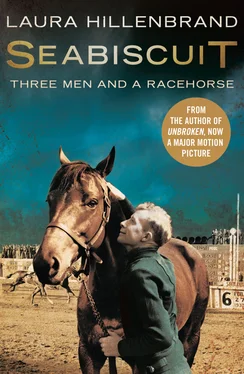
 Fatally injured when his horse collided with another runner, jockey Wallace Leischman lies on the track at Bay Meadows Racecourse, 1939. (TURF AND SPORT DIGEST )
Fatally injured when his horse collided with another runner, jockey Wallace Leischman lies on the track at Bay Meadows Racecourse, 1939. (TURF AND SPORT DIGEST )
